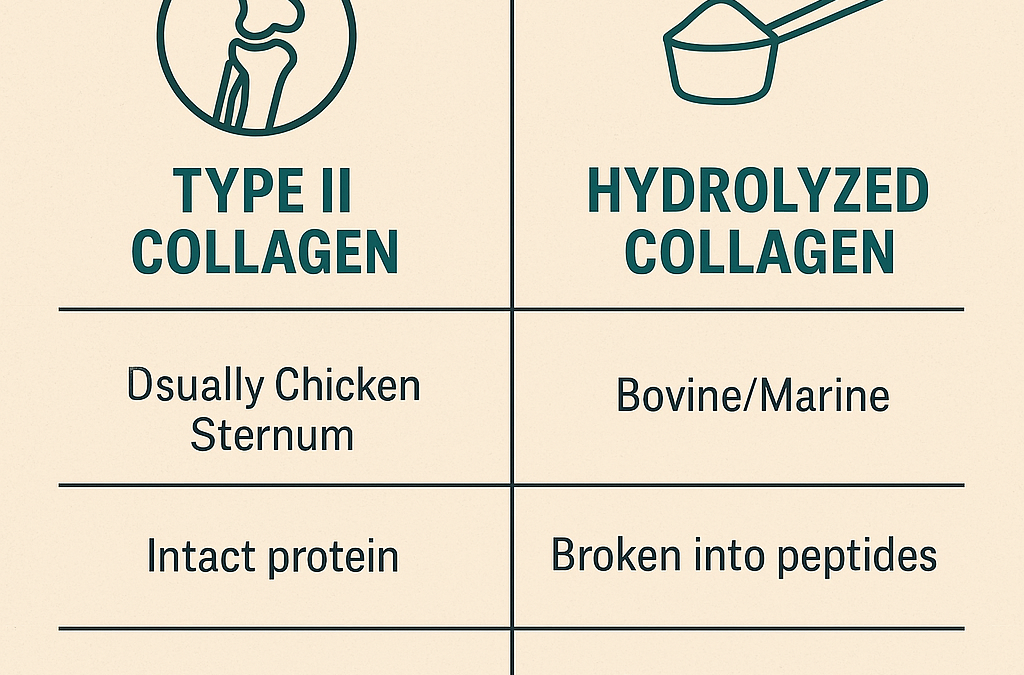If you’ve been exploring the realm of joint health or skin support, you’ve likely encountered the term collagen multiple times. However, here’s where it becomes a bit complex—not all collagen is the same.
Two popular forms found in supplements are Type II collagen and hydrolyzed collagen (also known as collagen peptides). Both offer health benefits but function very differently in the body. So, let’s break it down Herbal Pharmacist® style.
What Is Collagen, Anyway?
Collagen is the most abundant protein in the human body. Think of it as the “glue” that holds everything together—skin, bones, tendons, ligaments, and cartilage. As we age, our natural collagen production begins to decline, which is why many of us seek ways to support it through diet and supplementation.
Several types of collagen exist, but the ones you’ll hear about most in supplements are Type I, Type II, and Type III.
Hydrolyzed Collagen (Collagen Peptides): The Building Blocks
Hydrolyzed collagen is created by breaking down whole collagen proteins—typically sourced from bovine (cow) or marine (fish) into smaller peptides through a process known as hydrolysis, enhancing their absorption.
What it does:
- It provides the body with amino acids needed to build and repair connective tissues, build muscle, etc.
- Supports skin elasticity, hair and nails, muscle, and bone strength.
- It is often a mix of Type I and Type III collagen.
Key Point:
Hydrolyzed collagen is not targeted; it’s more like a general building material that your body can use wherever collagen is needed. Great for whole-body support, but not specifically for joints.
Type II Collagen: The Joint Health Specialist
Type II collagen is the main structural collagen in cartilage—the cushiony stuff between your joints. But here’s the twist: the undenatured form (Collavant n2®, for example) is taken in tiny doses (just 40mg per day) and works through an immune-mediated pathway, not just as a protein source.
What it does:
- Trains your immune system to tolerate your own cartilage, reducing the immune process that breaks collagen down.
- Helps improve joint comfort, mobility, and flexibility.
- Clinically shown to help with joint health at low daily doses (as little as 40 mg/day).
Key Point:
Undenatured Type II collagen isn’t broken down into peptides like hydrolyzed collagen. It needs to stay intact to activate that immune-modulating response.
What’s the Big Difference?
| Feature | Hydrolyzed Collagen | Type II Collagen (Undenatured) |
| Source | Bovine/Marine | Usually Chicken Sternum |
| Structure | Broken into peptides | Intact protein |
| Dose | Grams per day | Milligrams per day |
| Primary Benefit | Skin, bones, general collagen support | Joint comfort, mobility |
| Mechanism | Supplies amino acids | Modulates immune response |
Should You Take Both?
Honestly? Yes. They don’t compete; they complement each other.
- Take hydrolyzed collagen for skin health, muscle recovery, and general support.
- Add Type II collagen if you’re concerned about joint pain, stiffness, or mobility.
Think of hydrolyzed collagen as your foundation and Type II as your specialist contractor—both are important for building a resilient, healthy body.
Final Thoughts from the Herbal Pharmacist
Collagen isn’t just a trendy buzzword; it’s a powerful tool in the natural health toolbox. But the type and form you choose can make a big difference, depending on your health goals. So, next time you’re scanning labels or shopping for joint support, look beyond the word “collagen.” Ask: Which type? What form? What’s the dose? That’s where the real health benefits live.


